-
Making Decisions by Consensus Guidelines
Strengths of Consensus (“becoming of one mind”) Decision-Making Consensus, a way of making decisions without voting, can enhance the participation of all members in General Council meetings, provide a collaborative and harmonious context for making decisions, and enable representatives to discern together the will of God (Eph. 5:17) for the church and for MWC. Steps…
-
Methods and curriculum for teaching mission from an Anabaptist perspective
Lawrence YoderAAM MeetingEMS 12/8/00 “Methods and curriculum for teaching missions from an Anabaptist perspective” As look at the issues of teaching Christian mission, a very basic challenge is to invite students to discover God’s mission, and to get on board with what God is doing and wants to do in the world. The basic prayer…
-
Membership Application to the Global Anabaptist Peace Network (GAPN)
The Global Anabaptist Peace Network (GAPN) is a network that seeks to connect and support peace organizations (agencies, schools, training programs, research projects, think-tanks, activist-focused initiatives, activists, scholars) that have emerged from and serve our global Anabaptist-Mennonite church communion. Our hope is to provide a supportive community as we work together at making our world a better…
-
Making peace a way of life
During the past two years, MWC asked member conferences for accounts of experiences in peacemaking. MWC’s Peace Council considered these stories during two days of meeting in Bulawayo, Zimbabwe, in August 2003. The following summary was developed out of that discussion. 1. Continuum of peacemaking activities: All Christians are called to be peacemakers, but this…
-
Koinonia – The Gift We Hold Together
A teaching resource from the Faith and Life Commission The word koinonia has rightly become a central term and concept for Mennonite World Conference. In addresses, publications and programmatic efforts, leaders have been nudging the global Anabaptist community to a deeper relationship with each other. Even when we don’t use the word koinonia itself, much…
-
Identity and Ecumenicity: A Theology of Interchurch Hospitality and Denominational Identity
A teaching resource from the Faith & Life commission Mennonite World Conference embarked on the first formal dialogue process with the Baptist World Alliance in 1989. Since then, MWC has entered into conversations with Lutheran World Federation, Seventh Day Adventists, Catholics, and, most recently, a five-year trilateral dialogue with Lutherans and Catholics. Seeing the value…
-
Growing in faithfulness: Living out our baptism
Guide for study and reflection on Baptism and Incorporation into the Body of Christ, the Church: The Report of the Trilateral Conversations between Lutherans, Mennonites and Catholics 2012-2017 by Thomas R Yoder Neufeld, on behalf of the Faith and Life Commission This study guide is an aid for member churches of the Mennonite World Conference to receive and process…
-
God’s People in Mission: An Anabaptist Perspective
A Statement of the MWC Mission Commission God is a missionary God. Jesus is a missionary Lord. The Holy Spirit is a missionary empowerer. The entire Bible is a missional book. The whole church is a missional people. Therefore, by the grace of God, as an Anabaptist faith community 1. ORIGINS We lead people to…

